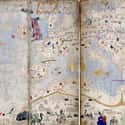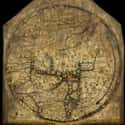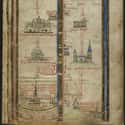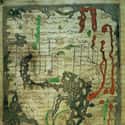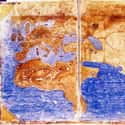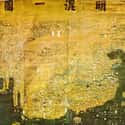-
(#11) Catalan Atlas, 1375
In the late 1300s, the most famous mapmakers in Europe were a family of Catalonian Jews. King Charles V of France commissioned the Catalan Atlas to show the most current geographical knowledge in the world, as of 1375. The map is an artistic creation that combines portolan chart geographic knowledge with hundreds of illustrations.
On the world map, you can spot Europeans traveling the Silk Road to China; a warrior elephant with sharpened tusks; the flags of various territories; and strange birds, animals, and people. The map also paints many of the islands, such as Corsica and Sardinia, in gold. Islands were a popular topic of fascination in the late medieval and Renaissance period, and multiple mapmakers created “Isolarios,” or books of islands, that would simply contain maps of different islands. On sea charts, islands were an obstacle to navigation, but they were also linked to the notion of a territorial state.
-
(#8) Hereford Mappa Mundi, Circa 1300
The Hereford mappa mundi shows what the simplified T-O structure looks like with more geographical details. This map, made around 1300, has been in England’s Hereford Cathedral for 700 years, capturing a medieval view of the world. Medieval and biblical history mingle on the map, which includes over 500 illustrations of people, animals, cities, and towns; 15 biblical events; and an array of strange creatures, odd people, and mythological images.
The variety in the Hereford mappa mundi points to its intended use: It is a visual chronicle of knowledge, mixing time and space to stun viewers with the scope of the world. And it’s no mistake that the Hereford mappa mundi is housed in a cathedral - it’s also a religious object meant to educate Christians on their place in the world.
-
(#4) Itinerary Map By Matthew Paris, Circa 1250s
At first glance, this medieval itinerary map by Matthew Paris doesn’t even look like a map. Instead, it’s a line of castles and buildings crossed by red text and blue waves. The map charts a route from London to the Holy Land, highlighting all the sights along the way. The mapmaker included rivers and hills, alternate routes, and places to stop on a religious pilgrimage.
At the bottom left of the map, you can see Matthew Paris’s depiction of London as a thick city wall ringing a blue church.
Like many medieval maps, this one was not intended to be carried on the road. It was an expensive work of art that may have been used for an imagined pilgrimage - one where the pilgrim never had to leave England.
-
(#5) Anglo-Saxon World Map, Circa 1025-1050
The Anglo-Saxon map, made in Canterbury between 1025 and 1050, contains the earliest known realistic depiction of the British Isles. However, it is almost unrecognizable as a world map, in part because it doesn’t follow many of the conventions of other medieval T-O style maps. Like the Tabula Peutingeriana, it recalls a Roman past by using Roman names for the provinces.
The British Isles are at the bottom left corner of the map, with Jerusalem roughly at the center, again showing the influence of religion on medieval mapmaking. As with many medieval maps, the top is east. Before the 1500s, there was no convention about putting north at the top of maps, and many placed east at the top because Europeans were convinced the biblical Earthly Paradise was in the Far East.
-
(#12) Medici-Laurentian Atlas, 1351
Some medieval maps are still recognizable today. Africa might appear a bit strange on the Medici-Laurentian Atlas map from 1351, but Europe, North Africa, and the Middle East are all remarkably accurate. That’s because the anonymous maker of this map, probably from Genoa, was trained in making portolan charts.
Portolan charts were used by sailors to navigate the Mediterranean and Black Seas. They required precise geographic knowledge so ships would not get lost. While this expensive and beautifully painted map would not have been taken out to sea, it incorporates knowledge from portolan charts. It also serves as a reminder that religious medieval maps were not produced because mapmakers lacked geographical knowledge, but because the maps served a specific purpose.
-
(#6) Da Ming Hunyi Tu Map, 1389
In China, medieval mapmakers produced the Da Ming Hunyi Tu, also known as the Composite Map of the Ming Empire, in 1389. The map, a full 15 feet wide, was painted on silk and showed the entire world as known to the Ming. It was also produced at a time of upheaval for China, when the Mongol Yuan rulers had only recently been expelled. In the late 1300s, China balanced between an international outlook, which had been promoted by Mongol rulers, and a more internal focus, promoted by more conservative factions.
Much of the knowledge in the Da Ming Hunyi Tu came from China’s many contacts with Muslim cartographers and intellectuals, and the place names on the western borders of the map are derived from Arabic names.
China would send out the voyager Zheng He to explore the world for nearly three decades in the early 1400s. But after his passing, Ming emperors decided to stop voyages of exploration and focus on China. As they argued, “barbarian” nations offered little of value to China’s prosperity.
New Random Displays Display All By Ranking
About This Tool
In the Middle Ages, people did not have map consciousness. As a new civilized world is being formed, the concept of maps that once existed in the Greco-Roman era is gradually dying out. Although some ancient Roman world maps were preserved until the early Middle Ages, they apparently disappeared as slowly as the dying classical traditions and knowledge, which also led to the production of strange maps at that time.
The knowledge and techniques of scientific mapping were not rediscovered until the 15th and 16th centuries. The random tool shows 12 weird maps of the Middle Ages that you must be interested in.
Our data comes from Ranker, If you want to participate in the ranking of items displayed on this page, please click here.











